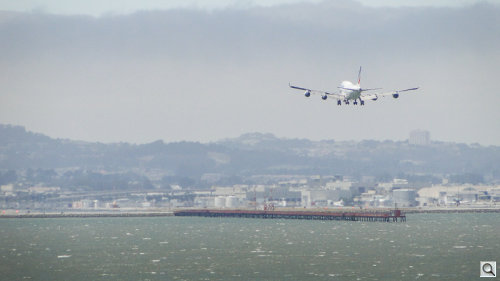Photo Corners headlinesarchivemikepasini.com
![]()
A S C R A P B O O K O F S O L U T I O N S F O R T H E P H O T O G R A P H E R
![]()
Enhancing the enjoyment of taking pictures with news that matters, features that entertain and images that delight. Published frequently.
Friday Slide Show: Coyote Point




29 July 2016
Just south of the San Francisco airport is a little peninsula right under the flight path called Coyote Point. It's a recreation area with picnic areas, a marina, hiking paths, a beach and a shooting range. Admission is $6 but in 2007 we managed to walk in for free.
We had a 9.1-megapixel Sony HX1 with a 20x zoom with us that blustery day. With a reach of 18-560mm on that lens, we thought Coyote Point would be a great spot to take photos of the big jets approaching SFO.
And we weren't wrong, as the slide show proves.
But there was a lot more to see at Coyote Point. We took a little hike along the beach where we could see wind surfers and sailboats. Then we continued up the hill to the other side of what was once an island to find a very nice marina, home to the Coyote Point Yacht Club.
There's also a playground and a nature museum with hands-on science exhibits that include live reptiles, amphibians, mammals and birds.
Lots to do but once there was even more.
In the Roaring Twenties, Coyote Point was the site of Pacific City, an ambitious amusement park that hosted 100,000 visitors on July 4, 1922, each of whom paid a dime to get in.
They could enjoy a beach made of 2,000 tons of trucked-in white sand, ride the Comet roller coaster with an 80-foot dip, elegantly dine in a converted Navy vessel and dance in a pavilion that held 2,000 couples.
But it closed in 1923. We'll let Kris Rowberry, host of The Lost Parks of Northern California, tell you why:
When we visited, though, the wind was the only unpleasant thing about the place.
The HX1 captures only JPEGs so our edits in Lightroom CC were light touches. We had to straighten a few horizons (the wind had us leaning one way or the other) but we didn't do much to these.
One reason was that there was a good bit of haze in the air, despite the sunshine. Things looked good when we looked up at the aircraft but not so distinct as we looked across the bay.
You might think that would be a good reason to use the Dehaze effect. We tried it but a heavy dose ruined the atmosphere, so to speak. Just the slightest touch improved things before they suddenly fell apart. We were shooting on a hazy day, though, so why contradict reality?
Realty always seems to have the last word.
